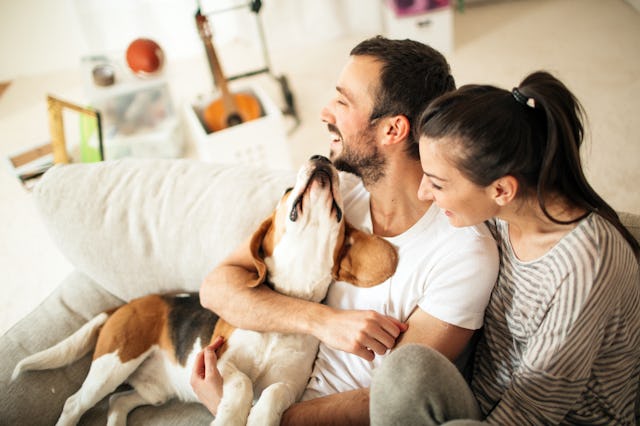So, Your Dog Only Listens To Your Spouse... What's Up With That?
Two vets are here to decode your dog's behavior.

From the moment you bring 'em home, your dog becomes part of your family. Not only do they offer unconditional, unwavering love and support, but that bond between your pets and your kids is unbreakable and magical for any parent to watch.
And while figuring out what they're thinking isn't easy (especially if yours is more of a "no thoughts, head empty" type of pup), you might notice that the furriest member of your family treats each human member a little bit differently. Maybe Fido obeys your spouse diligently but turns his nose up at your commands. Maybe Bella loves her mama but doesn't care much for anyone else.
Wondering what's the deal with this "pack member" mentality? Two vets are here to decode your dog's behavior.
Leader of the Pack
It's not just in your mind: Dogs do tend to assign different roles to people in a household, as PetMeds partner Dr. Lindsay Butzer, DVM, tells Scary Mommy. "They are social animals and naturally form a pack structure with their human family members. Each person might have a different relationship with the dog, and the dog may exhibit various behaviors to show their understanding of these roles. For example, a dog might be more submissive to one person (rolling over for belly rubs) and more assertive with another (jumping or barking)."
Other signs might include "seeking specific individuals for different needs (play, comfort, or protection), following certain family members more closely, and showing distinct behaviors or reactions based on each person's role in their lives," adds Dr. Victoria Hopson with The Vets. "These signs can indicate the strong bond and understanding dogs develop within a family dynamic."
A Happy Hierarchy
Within the pack, you might notice distinct differences in how your pup perceives the hierarchy, says Butzer. "Dogs may naturally try to establish order, recognizing leaders and followers. Signs of hierarchy include deference to certain family members, seeking approval or attention from perceived leaders, and respecting established rules. However, the dynamics can vary based on individual dog personalities and the family's interactions with them."
If it bums you out to notice that the family dog seems to be treating certain family members differently, Hopson notes that the dynamic "isn't as rigid as some might think. It can be influenced by various factors, such as the dog's breed, temperament, and individual experiences."
Alpha, Omega, Whateva
Butzer notes that the concept of an "alpha" is "a bit outdated and has been debunked by many dog behavior experts," so there's no need to take too much stock in it. "Instead, it's more accurate to say that dogs look to their human caregivers as leaders and providers of resources. So, while they might not consider their 'parents' as the alpha, they do look to them for guidance, safety, and sustenance."
That means your pup likely isn't looking to your kids as "betas" or "omegas," she adds. "Dogs might view kids as playmates or even as lower-ranking members of the pack due to their smaller size and less assertive behavior."
"Dogs often treat children with gentleness, especially if the children are taught to respect the dog's boundaries and signals," notes Hopson. "It's essential to supervise interactions between dogs and children to ensure a positive and safe relationship." More on this in a minute.
"If your dog seems to favor one family member over another, several positive reinforcement techniques can help balance the relationship," says Butzer.
- "Both 'parents' should participate in feeding, walking, and playing with the dog," she says. "This helps the dog associate both individuals with positive experiences and resources."
- "Reward good behavior with treats, praise, and affection," adds Hopson. "Make sure everyone is on the same page about the behaviors you want to encourage."
- "Practice obedience training together," says Butzer. "Both family members should take turns giving commands and rewarding the dog for following them. This helps establish both individuals as leaders in the dog's eyes."
- "Use consistent commands and cues among all family members," adds Hopson. "Dogs respond well to predictability."
- "Encourage bonding through play and affection," says Butzer. "Both family members should spend one-on-one time with the dog, engaging in activities the dog enjoys, and providing affection and praise."
- "Be consistent with rules and boundaries," suggests Butzer. "Ensure that both family members enforce the same rules and expectations for the dog's behavior. This helps the dog understand that both individuals are in charge."
The TL;DR here, per Butzer: "Every dog is unique, and their relationships with family members will vary. Patience, consistency, and positive reinforcement are key to helping your dog view both parents as leaders and caregivers."